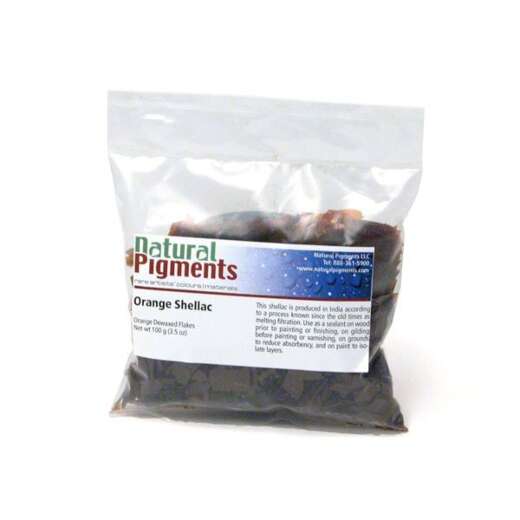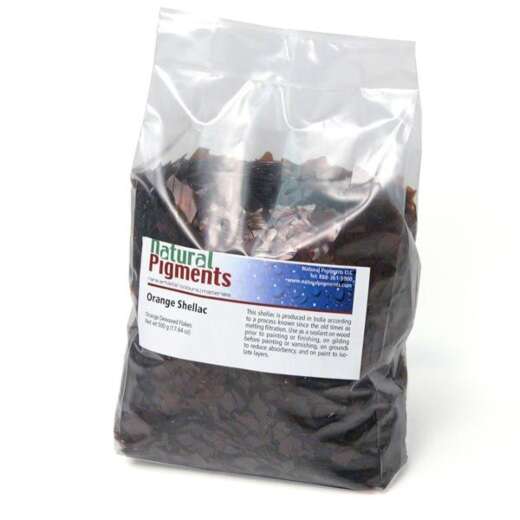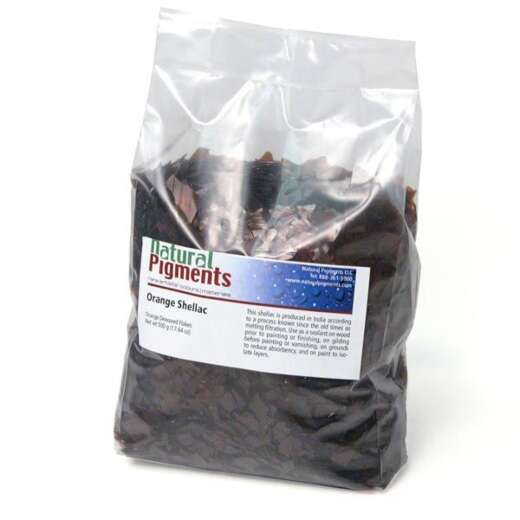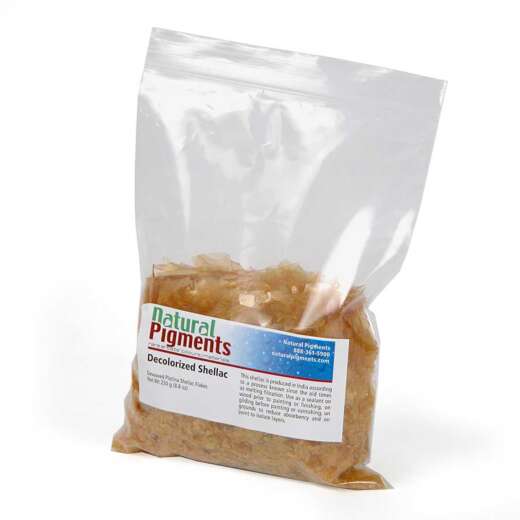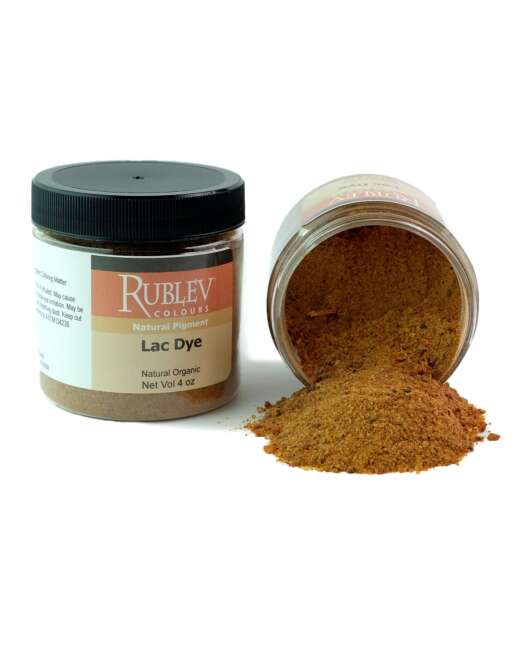Shellac—Applications and Use in Art

Shellac is a resin secreted by the female lac bug, Kerria lacca (Order Hemiptera, Family Coccidae), on trees in the forests of India and Thailand. The insect secretes resin forming tunnel-like tubes as it traverses the branches of trees. This insect is in the same family as the insect from which cochineal is obtained. The resin is collected, processed, and sold as dry flakes that can be dissolved in ethyl alcohol to make liquid shellac. Shellac forms a durable natural coating that is useful as a primer, sanding sealant, tannin-blocker, odor-blocker, and high-gloss varnish.

Platina dewaxed shellac flakes
Several variables grade shellac; its wax content and color are the two most common. The color of shellac ranges from pale yellow (“platina”) to a dark reddish-brown (“garnet”), with all shades of brown, yellow, orange, and red in between. The color is influenced by the sap of the tree that the lac bug lives on and the harvest time. Historically, the most commonly-sold shellac is called “orange shellac.”
Shellac naturally contains 3 to 5% wax, called “shellac wax.” The lower the wax amount, the better the shellac grade. Some grades of shellac are dewaxed. Dewaxed shellac has better transparency and moisture resistance. The wax in shellac reduces the finish’s clarity and the shellac resin’s molecular weight, making it less resistant to water. However, dewaxed shellac has a much shorter shelf life after mixing with alcohol (about six months).
Dry Flakes or Shellac Solutions
Once the dry flakes are dissolved in ethyl alcohol (ethanol), a chemical process known as esterification begins. The alcohol chemically modifies the shellac resin and turns it into a sticky gum that doesn’t dry. This is responsible for one of the most often heard complaints about shellac—that it doesn’t dry. Prominent manufacturers of shellac liquid preparations, such as Zinsser, label their cans with a shelf life date (three years). Still, the best results and working properties are achieved by preparing your shellac from dry flakes.
Dry shellac flakes store indefinitely under proper conditions, but contrary to what you may hear, they will not store forever. Given enough time, especially under hot, wet conditions, dry shellac reacts with itself to form polymers that are insoluble in alcohol. Shellac, which has been dewaxed, is more prone to aging. You can extend the usable life of dry shellac flakes by storing them in a cool, dry place.
To test shellac that you suspect has exceeded its shelf-life—dissolve the flakes in alcohol. Most shellac will completely dissolve within three days. If you see a gelatinous mass after this time, the shellac is past its usable life and should be discarded. Sometimes during the summer months, shellac will cake together. This is known as “blocking” and is not a sign of defective shellac. Break up the shellac with a hammer and dissolve it in alcohol as usual.
Dissolve dry shellac flakes in denatured ethyl alcohol sold in most paint stores. The alcohol should be anhydrous; that is, it should not contain water because water will cause the shellac solution to become cloudy or milky in appearance. Shellac also dissolves in methyl (methanol), butyl (butanol), and propyl (propanol) alcohol. Methanol evaporates the fastest, followed by ethanol, butanol, and propanol. The last two alcohols, butyl, and propyl, can be added to shellac dissolved in ethanol in small amounts to act as retarders, which make a shellac solution stay wet longer for better application (like brushing). Lacquer retarders can also be used. We do not recommend using methanol as a solvent because it is very toxic. In older literature, methanol is referred to as wood alcohol or methylated spirits, but its use is discouraged.
Once dissolved in alcohol, shellac eventually esterifies, as mentioned above. Although dissolved shellac can be successful after 12 months, shellac older than six months should be tested. Pour a small amount onto a piece of glass. It should be discarded if it does not dry to the touch within five minutes. For this reason, it’s a good idea to prepare only enough shellac that you plan to use within six months.
Preparing Shellac Solutions
The strength of shellac solutions is traditionally measured by a unit known as a “pound cut,” which refers to the amount in pounds of shellac flakes dissolved in a gallon of denatured alcohol. For example, a one-pound cut (“1-lb. cut”) of shellac is obtained by dissolving one pound of shellac flakes in a gallon of alcohol. A “5-lb. cut” is five pounds of shellac flakes dissolved in a gallon of alcohol. Most pre-mixed commercial preparations are 3-lb. cuts. Since a gallon is a large amount for most tasks, you can calculate the ratio to best suit your needs. For example, ¼ pound of flakes dissolved in one pint of alcohol yields a two lb. cut. It’s best to weigh the shellac flakes when preparing solutions. Small, inexpensive food scales calibrated in ounces are readily available from houseware supply stores.
Using Shellac
There are many advantages to using shellac. Low toxicity, ease of application, and ease of repair are the best reasons to use shellac. Yet, like any finish, there are some disadvantages. However, some reasons people cite as disadvantages are based on misconceptions. Two of the most common ones can be easily explained. The first is that it won’t dry. This problem can be avoided by using freshly dissolved shellac flakes. The second complaint is poor moisture resistance. This can be overcome by using fresh dewaxed shellac flakes. However, keep in mind that the ability of shellac coatings to resist water decreases with the age of the film.
Shellac is most often used in artwork as a sealing finish on wood or other porous substrates that will later be painted over. It can also be used as an isolating film between layers of paint, both oil and water-based. Dissolved in alkali and water, shellac can be used in watercolor painting as a fixative.
An exciting feature of shellac is that it resists water vapor very well. In tests done by the United States Forest Products Laboratory on the moisture-excluding effectiveness (MEE) of wood finishes—the ability of a finish to prevent moisture vapor from entering the cellular structure of the wood—shellac rated above polyurethane, alkyd, phenolic coatings, and cellulose-based lacquers.
Applying Shellac
Shellac can be applied by brushing, rubbing, and spraying. Artists, however, will find brushing to work best for most applications.
Applying multiple thin layers of shellac produces significantly better results than one or two thick layers. Thick coats of shellac do not adhere well to the substrate or each other.
The best brushes for shellac are those that hold a lot of material, allowing it to flow onto the substrate and avoiding excessive brushing. Perhaps the best brush for applying shellac is a fitch brush. Closely related to the ferret, the fitch (Mustela putorius), also known as a polecat, is a member of the weasel family throughout Europe and Asia. The best varieties come from Siberia and northeastern China. The fitch tail consists of very fine hair with a highly resilient conical shape and a thick belly. It is equal in quality to weasel (red sable) hair. Because fitch hair is in short supply, brush manufacturers have substituted fitch hair with a blend of natural and synthetic hairs while still calling it “fitch.” Some imitation fitch brushes perform almost equally well to the genuine article. Genuine fitch and sable brushes are more expensive than imitation varieties. If you’ve never used an expensive brush, you’ll quickly realize it’s worth the price.
Before brushing, dip the brush just below the ferrule (the metal part between the handle and the hair) into alcohol and then press it out. This makes the brush easier to clean afterward.
A dilute solution of shellac is easier to apply and minimizes brush marks that may be hard to rub out later. Start with a 2 to 1-1/2 lb. cut for brushing. Dip the brush about halfway into the solution, raise the brush off the solution, and let the excess shellac run off, then drag the hair of the brush lightly across the top of the jar or can. Starting away from the edge, drag the brush lightly to the edge, then return to the other edge. Brush once and quickly come back to even out the film if it appears uneven. Don’t overwork what you’ve applied.
Brush another coat next to the previous one, slightly overlapping it by about a 1/4 inch. Work down the substrate until it is covered and then do the edges, if needed. Allow the shellac to dry (one hour for the first coat, overnight for subsequent coats), then sand and polish with steel wool. Three coats should be sufficient to seal close-grained woods like cherry or maple, but four to five coats may be necessary on open-pore woods like mahogany.
To clean your brush, you do not need to use alcohol. Household ammonia cleans shellac brushes well because the ammonia dissolves the shellac. Wash the brush with soap and water afterward to keep the bristles soft.




